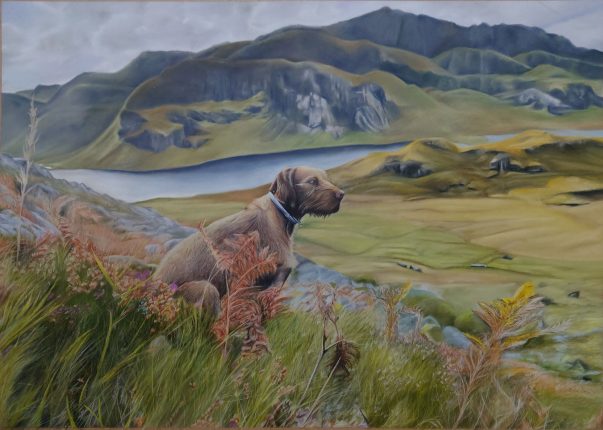Emma Cawston uses oil pencils to draw country scenes in meticulous detail, a painstaking process but one she relishes, says Janet Menzies
Emma Cawston, a country bumpkin at heart, has journeyed from Africa to the UK countryside with her oil pencils and has a diverse portfolio of fantastic paintings of wildlife and the sport of shooting. Janet Menzies talks to her to find out her process.
SPORTING ARTIST: EMMA CAWSTON
It feels as if country sports face unrelenting millennial criticism, so it is heartening to discover Emma Cawston’s journey from working in Africa on elephant conservation to being a countryside artist who can accurately portray the difference between a Beretta and a Browning: “People ask me, is there not a clash between my belief in conservation and the environment, and my drawings of shooting and country activities – but surely the countryside way of life is all about conservation?”

Cawston describes herself as a country bumpkin at heart, although her family lives in Sweden and she didn’t have a conventional country house upbringing. It was on a visit to Sweden after coming back from Africa that Cawston first picked up a pencil. “My husband and I were staying with my brother, and I thought I might do some drawings and see if I could make some money, and it took off really well.” Although Cawston had little formal art training, by the time she and her husband had settled in Wales, she found plenty of admirers not just for her subject matter but her unusual choice of medium – oil pencil. “Everything I do is in coloured pencil,” she explains. “I did try acrylic paint, but I find the pencil is more free-flowing, and the pencils I use are environmentally friendly, which is also important to me. I spent a long while practising, and I will still always be learning. When I look back at how I started, I can see that the work really has come a long way.”
While the pencil gives Cawston amazing capacity to capture detail, it is painstaking work, so she has had to find a solution for larger pictures. “I also use pan pastel, which is a very fine powder, for the areas like landscape and backgrounds of sky and grass. I use a sponge to put a layer of pan pastel down, which gives a soft focus feel, and then I can put the pencil on top. Using these pencils rather than oil paint means you don’t get a second chance if you make a mistake – so you have to get creative and improvise.”
However, when a series of commissions suddenly came in from the Scandinavian owner of Scottish sporting estates, Cawston did worry that she and her technique might have met their match. “Out of the blue, I got a message from this country estate owner,” she remembers. “I was sent six photos – I thought they would choose just one, but they wanted all of them. And then the frames arrived and they were massive. I thought, ‘Oh my goodness, where am I going to put these?’ There I am, stacking them up, and I have no idea where I am going to put them all – they are bigger than I am. I said to myself, ‘We are going to have to improvise’, and they ended up going in the kitchen. When I had finished, I got invited up to drop the stuff off, and I drove up the drive of this grand estate and felt like I should be in a Rolls-Royce. Yes, I think I was naive to take it on, but it did turn out to be a complete success. And I want to challenge myself; this is the way I want to go.”

The aim of challenging herself is what originally brought Cawston into shooting and guns as subject matter: “I was working in collaboration with a photographer friend, which ended up with me doing drawings of shoots and guns. The guns themselves were a challenge that interested me as I had never drawn anything that wasn’t organic before.” Yet she instinctively recognised a connection between her own detailed work in pencil and the gun engraver’s meticulous etching of lines on metal. “Engraving fascinates me. I love looking at these beautiful guns – I find there is something very creative about them. I am doing a lot more work at the moment depicting guns and their design.”
It may be the tactile and three-dimensional quality of guns that is taking Cawston to a new departure into work using resin and wood. “I have to work this out, because I still want to work on paper – I can’t just draw straight on to wood or resin.” Her solutions will be something to look forward to. Some of her conservation marine animal subjects, such as sea turtles, would look magical swimming through a resin sea, and Cawston has ideas for backlighting completed works. First, though, she must finish her new work for The Game Fair. “I like to donate some work for various charities as well when I exhibit at The Game Fair or the Welsh Game Fair,” she explains. “I have done work recently to support the National Military Working Dogs Memorial that I hope will raise some money to establish the memorial.”
For more information or to contact Emma Cawston, visit: emmacawston.com
See her work at the Welsh Game Fair in Bangor on 9-11 September.




